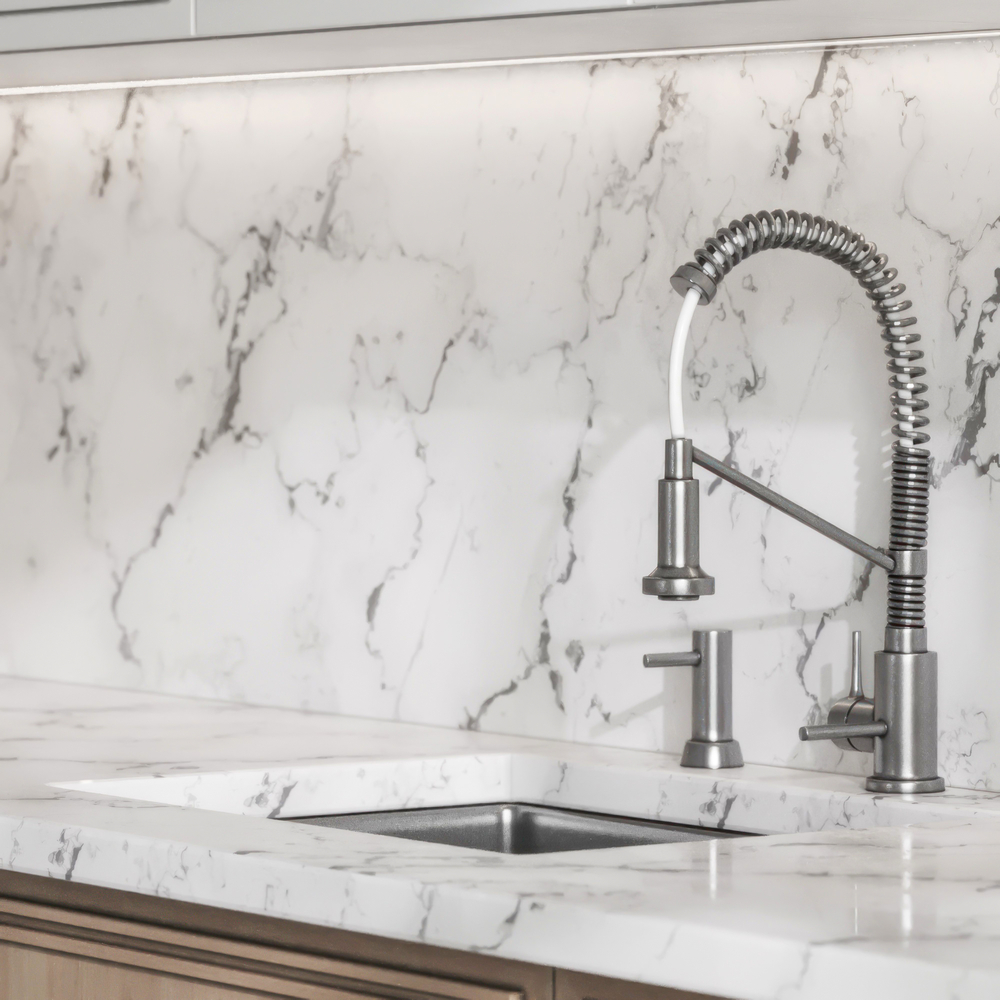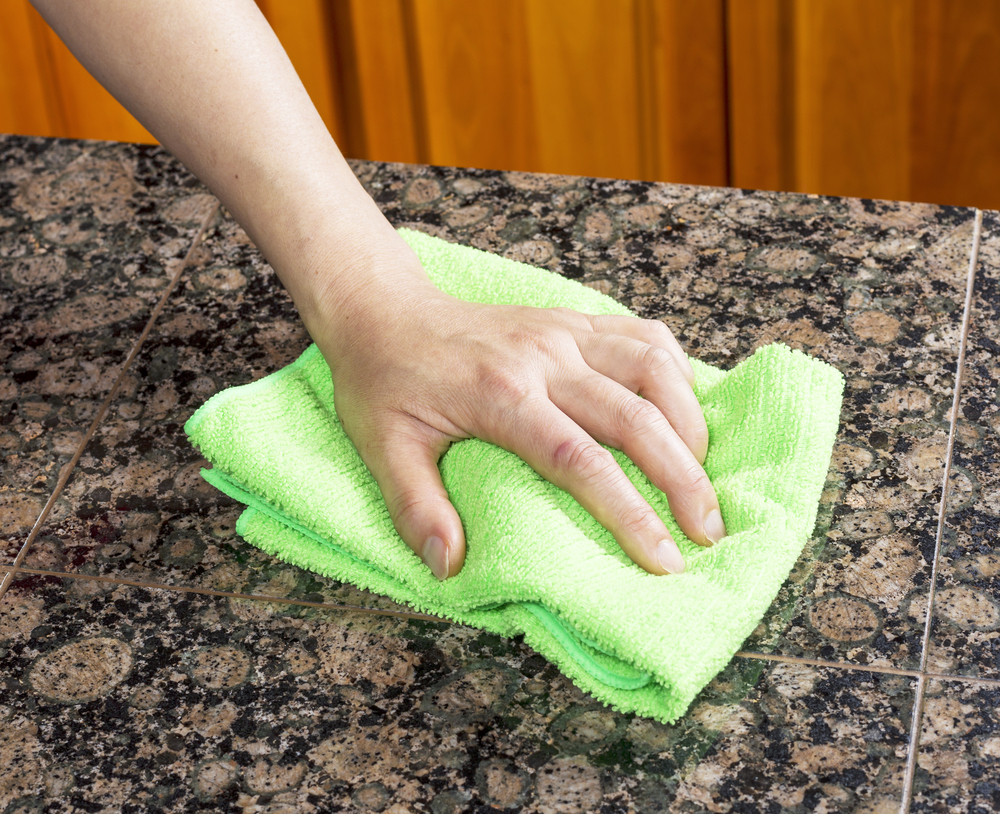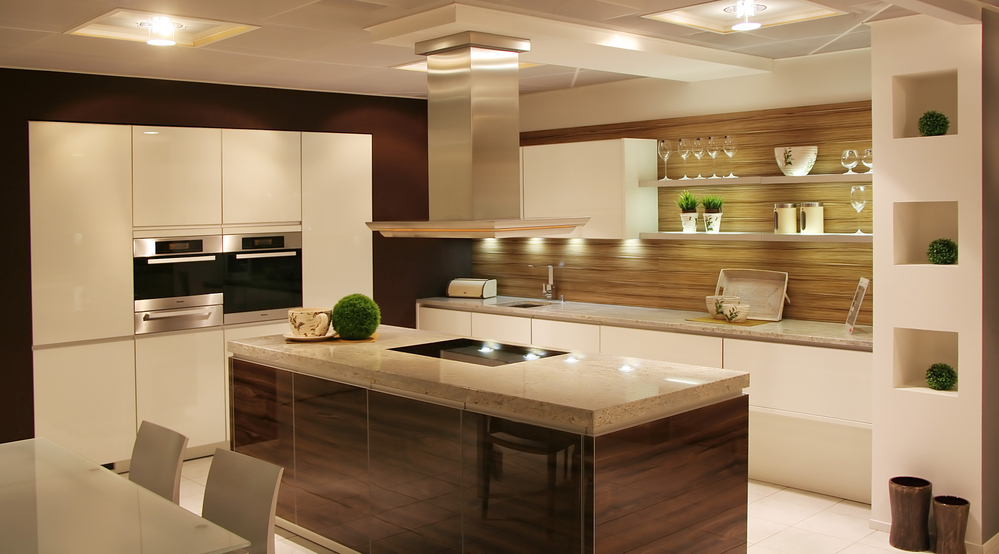When picking a stone material for your home, sintered stone and marble are two popular choices. However, there are certain things to keep in mind before you make your decision. Whether you are going for a timeless look with marble, or a contemporary style with sintered stone, here is what you need to know before making your purchase.

Sintered Stone
What is sintered stone?
Sintered stone is a custom-made material that consists of natural minerals like quartz and feldspar, pigments, and binders. It is eco-friendly because it doesn’t contain harsh chemicals such as adhesives, resin, or other bonding agents, and doesn’t emit harmful gases during production. It’s also a recyclable and renewable material.
How is it made?
To create sintered stone materials, raw minerals are extracted from the ground and transported to a manufacturing plant where they undergo various stages of processing to replicate hundreds of years of metamorphic change. The key steps involve mixing the raw materials together until they form a uniform mixture, pressing the mixture into a slab, removing moisture through drying, sintering the mixture, and finally cooling it down. Sintering is a process that involves the fusion of particles using high temperatures and pressure, resulting in a strong and long-lasting stone slab. It is extremely hard with a score of 7 on the Mohs scale of mineral hardness.
Scratch- resistant
Its hardness and durability are why it is highly scratch-resistant, making it an excellent choice not only for your bathroom but for kitchen countertops and flooring as well. It can even be used in outdoor applications, as it is weather-proof and water-proof. It also does not get discoloured under UV radiation.
Stain- resistant
Sintered stone countertops are excellent in both the bathroom and the kitchen. It’s stain-resistant, so you can dye your hair at home and not have to worry about discolouring your surface with hair dye – though you have to be careful with the bleach. It’s also great in the kitchen where there are bound to be spills from various liquids and foods that would stain surfaces.
Heat- resistant
On bathroom countertops, you can place heating tools such as hair straighteners or curlers directly on your countertops without leaving a mark. The same goes for kitchen countertops – you can place a hot pan directly on the surface. Just be careful not to immediately place something cold in the same spot, as the sudden temperature change may cause cracking.
Nonporous and low-maintenance
Sintered stone countertops are hygienic because it is a non-porous material and therefore has no pores for bacteria to grow in. You can spill as much of your skincare products and soap on your bathroom countertop or food and drinks on your kitchen countertop without worry. Sintered stone is a low-maintenance countertop material that does not need to be sealed and routinely resealed. The surface can be cleaned with a soft cloth or sponge, warm water, and a pH-neutral cleaner.
Customised design
Sintered stone offers a wide range of design options as its texture, colour, and pattern can be customized according to your preferences. However, the design does not go throughout the thickness of the slab, because it is printed on the face of the slab. Meaning, the ends and edges do not look the same as the rest of the surface. The sintered stone’s design can be customised to have random veining to mimic the appearance of marble, granite, other stone materials, and even wood. Or it can be customised to have a uniform appearance, which helps minimise the appearance of seams on the surface. However, very fine details will be lost during the sintering process. What would not disappear is its texture, which makes the material good for flooring because of its anti-slip properties.
Marble
What is Marble?
Marble has been used in sculptures and architecture for over 2000 years and adds a luxurious touch to the surrounding environment. In the world of art, it is one of the most popular choices for sculptors because of its durability and translucency. It’s easy to work with because it’s a soft stone, and it can be manipulated into the shape the sculptor wants. The finished product then gradually transforms into a hard and dense material over time. Marble has a low refractory index due to the presence of calcites, allowing light to penetrate the stone, similar to how light interacts with human skin. This gives marble sculptures a “waxy” appearance, making them more lifelike. This is why marble is known for its natural beauty and timeless appearance which makes it synonymous with elegance and opulence.
How is it made?
Marble is a stone material formed through a natural process in which extreme heat causes minerals in limestone rock to grow and fuse together. The marble is quarried, cut into a solid slab, and then polished to create the finished product. It is a soft stone with a score of 3-4 on the Mohs scale of mineral hardness. It comes in a wide variety of colours, though the purest marble is white. It’s tiering and price depends on the veining and colour of the marble.
Porous
Like all natural stones, marble is a porous material, so it is important to get a quality sealant to protect your surface from liquids getting into the pores and becoming a breeding ground for bacteria. The sealant also protects your surface from acidic household liquids such as lemon juice and vinegar, which will dissolve the calcium carbonate that’s found in marble. To clean the marble surface, use a soft cloth or sponge, warm water, and regular dish soup. Then use a second clean cloth to dry.
Heat-resistant and keeps things cool
In terms of heat resistance, Marble can take temperatures up to around 176 degrees Celsius (350 degrees Fahrenheit). However, it is strongly advised not to apply intense heat directly on this stone surface, as it may cause discolouration, chips, or cracks in the sealant. Marble itself is a poor conductor of heat, so it always feels cool to the touch. Bakers use these marble surfaces to keep the butter in the dough cool, which is important to get a flaky baked good. Marble also keeps the room cool, making it a great choice for your bathroom countertops if you live in a hot country. It is not recommended to use marble flooring in your bathroom without a sealant because of how damp and wet the environment is. However, if you are planning to have marble flooring for the rest of your home, do take note that it is a slippery surface.
Not stain- and scratch-resistant
Unfortunately, marble is not the best material when it comes to stain resistance and scratch resistance. Marble is known as a “living finish” because time and wear cause it to change by getting slightly darker and having more etchings, but some people like it because it “gives the marble personality.” You could have marble as your kitchen countertop material, but it would require a lot of maintenance and care. It might be easier to have a large board that’s made of marble just for baking – like a chopping board, but do not use it as such, because knives will surely damage the marble and sealant with chips and cracks.

Weighing Your Options
While both sintered stone and marble are ideal choices, it depends on what you are looking for. Would you go for the versatility of the artificial stone material or the elegant appearance of natural stone material? Take into account the key differences between the two materials before you make your choice.
From a logical point of view, sintered stone is the way to go. It is the harder material and unlike marble is scratch-resistant and stain-resistant. It is also cheaper and easier to install and maintain than marble. Due to advanced technology, sintered stone slabs can even be customised to look like marble, although they cannot match the exquisite beauty of marble exactly. Furthermore, this is the more eco-friendly option as sintered stone is recyclable and is composed of natural minerals and binders. There are no harmful chemicals or resin involved. It also does not emit carbons during its manufacturing process. Marble can be ground up and used in concrete, so it is recyclable too. But it is not as eco-friendly because it’s a natural stone that has to be mined out of the earth. In other words, it’s a finite, non-renewable resource.
When it comes to aesthetics, marble is the clear winner. The unique veining patterns and colour variations of natural marble make it the perfect choice for luxury countertops, flooring, and other surfaces in the home. Its history and cooling effect also give it an advantage. Marble also has a timeless appeal that will never go out of style. While the colour will darken and more etchings will appear on your surface as time passes, some people prefer this because of its organic change.
In the end, it all comes down to your personal preference and lifestyle. If you’re looking for a luxurious, natural look, marble is probably the way to go. But if you’re looking for a reliable material with more durability and versatility, sintered stone might be just what you need.





